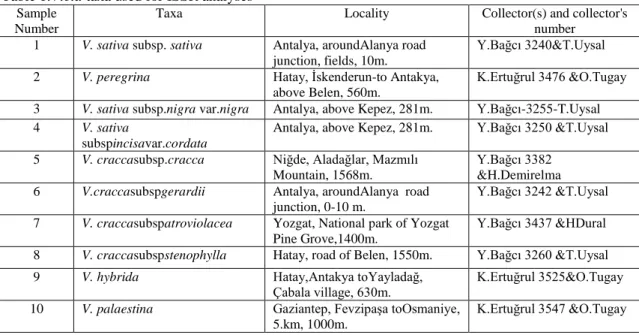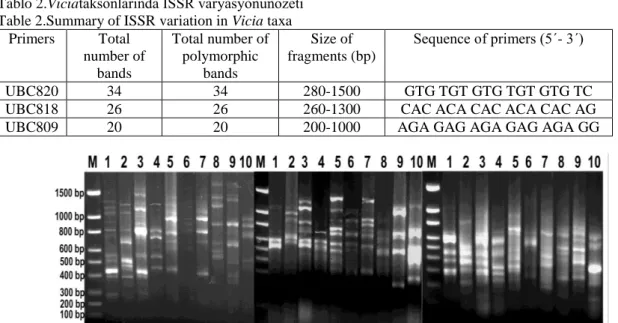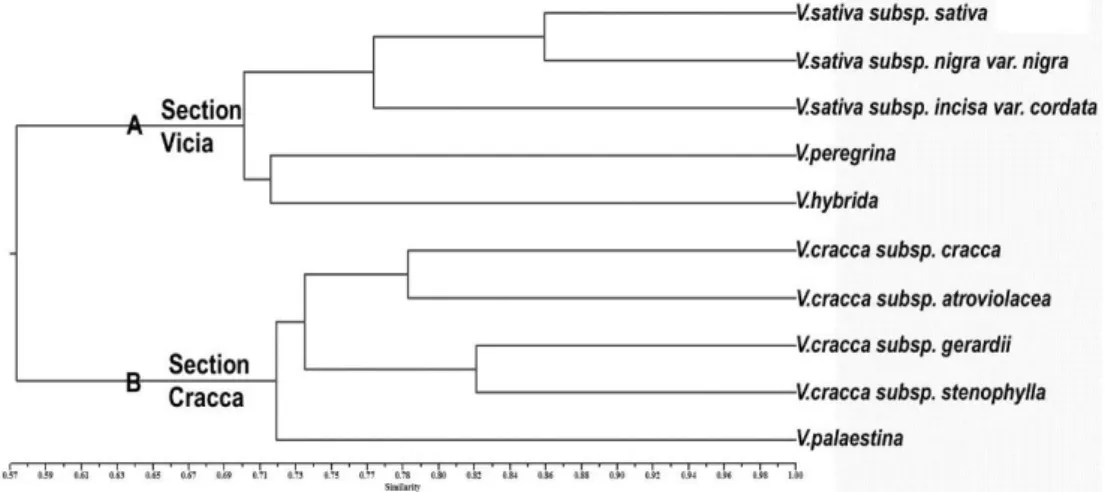www.biodicon.com Biological Diversity and Conservation
ISSN 1308-8084 Online; ISSN 1308-5301 Print 6/3 (2013) 135-139
Research article/Araştırma makalesi
The determination of genetic relationships among someVicia L. (Vetch) taxa by using ISSR markers ** Meryem BOZKURT *1,2, Kuddisi ERTUĞRUL 1, Tuna UYSAL 1
1 Department of Biology, Science Faculty, Selçuk University, Konya, Turkey 2 Advanced Technology Research and Application Centre, Selçuk University, Konya, Turkey Abstract
The genetic relationship among some naturally growing Vicia taxa in Turkey (V. sativa subsp. sativa, subsp.nigra var.nigra, subspincisavar.cordata, V. craccasubsp.cracca, subspgerardii, subspatroviolacea, subspstenophylla, V. hybrida, V. peregrinaandV. palaestina) was assessed by helping ISSR markers. During PCR assays, although 17 primers were tested, only three primers produced informatics amplification yields for all studied taxa. These ISSR primers had considerably high number of polymorphic locus. According to the dendogram obtained from ISSR profiles, all studied taxa were separated into two main clusters; one of them consists of the section Vicia and the other section Cracca. While the section Vicia comprises the subspecies of V. sativa, V. hybridaand V. peregrina, the section Cracca involve in subgroupsof V. cracca and V. palaestina.
Key words: Vicia, vetch, ISSR markers, Turkey
--- ---
ISSR markırlarıkullanılarakbazıVicia L. (Fiğ) taksonlarıarasındakigenetikakrabalıklarınbelirlenmesi Özet
Bu çalışmada, Türkiye’de doğal olarak yetişen bazı Vicia taksonları (V. sativa subsp. sativa, subsp. nigra var. nigra, subsp incisa var. cordata, V. cracca subsp. cracca, subsp gerardii, subsp atroviolacea, subsp stenophylla, V. hybrida, V.peregrina ve V. palaestina) arasındaki genetik akrabalıklar ISSR markırları yardımıyla değerlendirilmiştir. PCR denemeleri sırasında, 17 primer test edilmesine rağmen, sadece üç primer çalışılan tüm taksonlar için bilgi verici amplifikasyon ürünleri vermiştir. Seçilen ISSR primerleri tüm taksonlarda oldukça yüksek sayıda polimorfik lokus oluşturmuştur. ISSR bantlarından elde edilen dendrograma göre, incelenen taksonlardan Vicia seksiyonuna ait olanlar ile Cracca seksiyonuna ait olanlar iki alt grup olarak ayrılmıştır. Vicia seksiyonu alt kümesi, V. sativa’nın tür altı taksonları ile V. hybrida ve V. peregrina türlerinden; Cracca seksiyonu alt kümesi ise V. cracca’nın alt türleri ile V. palaestina türünden oluşmaktadır.
Anahtar kelimeler: Vicia, fiğ, ISSR markır,Türkiye 1. Introduction
The legumes family (Fabaceae / Leguminosae) includes 730 genera and 19400 species (Mabberley, 1997) and is considered as the third largest family of higher plants and is second to grasses in agricultural importance (Young et al., 2003). It has approximately 1128 taxa in 69 genera in Turkey; the number of endemic species and the rate of endemism are 375 and 39.1 % respectively (Davis &Plitmann, 1970; Davis,1988;Seçmen et al., 1989).
The genus Vicia, together with genera Lathyrus L., Lens L. andPisum L.is a member of tribe Vicieae, divided into two subgenera, Vicia and Vicilla (Kupicha, 1976). It includes about 150 annual and perennial herbaceousspecies, widely distributed throughout the temperate zones of both hemispheres. Approximately 40 species, mainly of Eurasian origin, are cultivated (Harlan, 1956).
**Footnote: This article was produced from master thesis.
*Corresponding author / Haberleşmeden sorumlu yazar: Tel.: +903322231862; Fax.: +903322231862; E-mail: mbozkurt@selcuk.edu.t
In Flora of Turkey, it is divided into six sections as Cracca,Ervum, Trigonellopsis, Anatropostylia, Vicia, and Faba. It is reported that Vicia has got totally21 varieties, 23 subspecies and 64 species in Turkey; five species and three subspecies of them is known to be endemic in that country (Davis &Plitmann, 1970). Vavilov (1951) reported that Turkey is a gene center for Vicia sativa species.
Classification of most of the Vicia taxa is not easy by using conventional taxonomical techniques.Molecular biology and gene technology are creating promising possibilities for a rapid and accurate determination of phenotypic and genetic variation among plant species (Agar et al., 2006; Uysal et al., 2012).
Many species of Vicia are highly variable in point of both genetically and response to environmental differences. Homologous variation is widespread (Davis &Plitmann, 1970).
V. cracca is a very polymorphic species, therefore, it is particularly difficult to distinguish between inherited variation and phenotypic plasticity in this complex. The complex is most variable in the Balkans, Anatolia and Caucasia. The five subspecies recognized for Turkey form a partly discontinuous series.. Although the V. craccacomplex were studied biosystematicly in Europe, almost nothing is known about the cytogenetic of this group in Anatolia and Caucasia.
The cosmopolitan species, V. sativa is one of the most variable in point of genetic and phenotypic features within the genus. Five main taxa, at subspecific rank,can be distinguished in the complex. The variability in all taxa, or populations, ofV. sativa is homologous, parallel and consequently overlapping. Many of thesubdivisionsare known to interbreed with each other. The species show considerable variations in almost every trait, but particularlyin leaflet morphology and in basic chromosome number (Davis &Plitmann, 1970).
By using ISSR markers, some molecular studies including genetic diversity in Viciawere reported in recent years (Terzopoulos&Bebeli, 2008; Noorozi et al., 2009; Han & Wang, 2010; Wang et al., 2012). In this paper, some problematic and complicated Vicia taxa fromTurkey were investigated in view of their genetic distance and intraspecificinteractions byhelping ISSR markers.The aim of this study was also to evaluate the genetic relationship of the some Turkish Vicia, particularly for sectional level, to check the concluded genetic findings how much would be compatible with Flora of Turkey.
2. Materials and methods 2.1. Plant Material
Ten Vicia taxa used in this study were collected mainly from different locality of Mediterranean region in Turkey.Voucher specimens were deposited at KNYA; the Herbarium of Biology Department at Selçuk University, (Table 1).
2.2. DNA extraction
Total genomic DNA was extracted following the 2xCTAB method of Doyle and Doyle (1987) as modified by Soltiset al. (Soltis et al., 1991) and Cullings (1992) from silica gel-dried leaves collected in the field.
Tablo 1. ISSR analizleriiçinkullanılanViciataksonları Table 1.Vicia taxa used for ISSR analyses
Sample Number
Taxa Locality Collector(s) and collector's
number 1 V. sativa subsp. sativa Antalya, aroundAlanya road
junction, fields, 10m.
Y.Bağcı 3240&T.Uysal 2 V. peregrina Hatay, İskenderun-to Antakya,
above Belen, 560m.
K.Ertuğrul 3476 &O.Tugay 3 V. sativa subsp.nigra var.nigra Antalya, above Kepez, 281m. Y.Bağcı-3255-T.Uysal 4 V. sativa
subspincisavar.cordata
Antalya, above Kepez, 281m. Y.Bağcı 3250 &T.Uysal
5 V. craccasubsp.cracca Niğde, Aladağlar, Mazmılı Mountain, 1568m.
Y.Bağcı 3382 &H.Demirelma 6 V.craccasubspgerardii Antalya, aroundAlanya road
junction, 0-10 m.
Y.Bağcı 3242 &T.Uysal 7 V. craccasubspatroviolacea Yozgat, National park of Yozgat
Pine Grove,1400m.
Y.Bağcı 3437 &HDural 8 V. craccasubspstenophylla Hatay, road of Belen, 1550m. Y.Bağcı 3260 &T.Uysal 9 V. hybrida Hatay,Antakya toYayladağ,
Çabala village, 630m. K.Ertuğrul 3525&O.Tugay
10 V. palaestina Gaziantep, Fevzipaşa toOsmaniye,
5.km, 1000m.
2.3. Inter Simple Sequence Repeats(ISSR)-PCR
Our modified ISSR-PCR analyses were basically performed according toZietkiewicz et al. (Zietkiewicz et al., 1994). During PCR-optimization reactions, some modifications were quantitativelycarried out particularly for Mg and primer amounts as well as Tm selection. The designedISSR primers by British Colombia Universitywerepreferredfor PCR-amplifications. Amplification products were separated by electrophoresis in 1.2 % agarose gel run in TAE buffer at 100 V. Fragment size was estimated by using a 100-1500 bp molecular size DNA ladder.
2.4. Data analysis
ISSR profiles were scored as present (1) or absent (0). Only reproducible bands were scored as monomorphic or polymorphic. Dendrogram was performed using NTSYS-pc version 2.1 (Rohlf, 1998).
3. Results and discussion
Totally 17 ISSR primers were tested during ISSR amplifications of Viciataxa. Although nine primers previously worked in our experiments during ISSR-PCR amplifications, three primersproduced only clear informatics bandsto evaluate genetic relationship among the studied species.The obtained DNA profiles werethen manually scored for each taxa, 1 for presence and 0 for absence, to generate a data matrix. A total of 80 amplicon in the size range200-1500 bp were produced viathree different primers for ten taxa (Table 2andFig.1).
Tablo 2.Viciataksonlarında ISSR varyasyonunözeti Table 2.Summary of ISSR variation in Vicia taxa
Primers Total number of bands Total number of polymorphic bands Size of fragments (bp) Sequence of primers (5´- 3´) UBC820 34 34 280-1500 GTG TGT GTG TGT GTG TC
UBC818 26 26 260-1300 CAC ACA CAC ACA CAC AG
UBC809 20 20 200-1000 AGA GAG AGA GAG AGA GG
Figure1.Electrophoresis Patterns of ISSR products amplified with primers UBC820,818,809 for Vicia taxa Şekil 1.ViciataksonlarıiçinUBC820, 818, 809 primerleriileçoğaltılan ISSR ürünlerininelektroforezpatternleri In dendrogram, Vicia taxa were clearly distinguished in level of section, species and alsosubdivisons.The dendrogramindicated that there are genetically two main group (Fig.2). The firstgroup consisted ofV. sativa and itssub-categories, except fromV.peregrina and V.hybrida.In the identification key of Flora of Turkey, these two species are separated basically by flowers color and indumentums characters existing on upper surface of the standard. Unlike V. hybrida, the standard of V. peregrina is without hair and itscolors are partly variable (violet or sometimes whitish)comparing to V. hybrida having sulphure yellow flowers.In spite of several differences among them, they would be evaluated relative species according to common vegetative and generative features and they take place together within the same section in conclusion.According to our molecular analyses, V.peregrina and V. hybridawere placed in the outer part of V. sativa complex by distance ca. 31 %. They are related with 72 % genetically. The secondgroup consists of V. cracca’s subspecies and V.palaestina.V. cracca is a perennial species and fairly polymorphic species. Itshows many variations in point of leaflets numbers, shape as well as flowers sizes and colors. V. palestianais an annual species that it can be separated easily with smaller calyx than species of V. cracca complex. It can be sad clearly that the relationshipof two species is not very much when compared their morphologic features. V. palaestinatook place genetically alone as compatible with its morphology, and it closely related to sister clade by rate of similarity 78 %. In the sister clade, four taxa belonging to V. cracca were placed by distance furthest 24 %. V.craccasubspcraccaand subsp. atroviolacea took place together by distance 22 %, while V.cracca subsp. gerardii and stenophylla were positioned as a twain by distance 18%. The subtaxaof V. cracca complex was classified basically
according to flowers, peduncle and raceme size besides flowers color in Turkish Flora.V. cracca subsp. atroviolaceais specified as having large flower with very dark violet and short peduncle. On the other hand, our molecular results don’t support this main diagnostics coming from the past relevant to morphological descriptions.Also, the observations sourced from our field studies indicated that flowers size and color show broadly variation within V. craccacomplexand these features could not be used certainly to identifyin lower categories of species. Instead of these, we can suggest using the ratio of flowers claw to lamina for V. cracca complex. The highest differentiation rate withinV.sativawas determined as 23 % and therefore the furthest taxon within this cladewas V. sativa subsp. incisa var. cordata. Already, this taxon can be easily separated than other relativeswith cordate leaves. The remainingtaxa of this group were closely related and genetically differences among them were lower than previous by distance 15 %. These two taxa, V. sativa subsp. sativa and subsp. nigra can be recognized by fruit shape, so that the fruit formation depicted as "torulose" is very characteristic for the first taxa. As conclusion, these molecular findings support strongly sectional divisions of Vicia genus such in Flora of Turkey, and also coincidedexactly with results of Agar et al.(Agar et al., 2006).
Figure 2.The dendrogram explaining the genetic relationship of the Viciataxa Şekil 2. Viciataksonlarınıngenetikakrabalıklarınıaçıklayandendogram
ISSR analyses have been focal point to explore genetic diversity in many plant taxa since last decade(Sica et al., 2005; Venkatachalamet al., 2008; Han, 2010; Wang, 2012; Uysal et al.,2012) and they haveused confidentially on the contrary other molecular approaches such as RAPD. They not only assist to systematical and taxonomical studies, but can be used faithfully to develop new agronomical varieties and lines in all legumes.ISSR markers aredominant DNA markers, having high resolution power and hence appear to offer many advantages in establishing genetic distances. Therefore, we suggest that ISSR markers can be preferred firstly to select new genotypes ofV. sativa havingagronomical importance and economic values.
According to our results, ISSR has been very useful to determine genetic differences within and among of Viciaspecies as well as sectional classifications. As a consequence, ISSRs are also very promising genetic markers for identification of Vetches cultivars. Because of their good discrimination efficiency and high reproducibility, they are particularly suitable to identify the closely related species and varieties.
Acknowledgements
We would like to thank the following Prof. Dr. Hüseyin DURAL, Prof. Dr. YavuzBağcı, Assoc. Prof. Dr. Osman TUGAY and Assist. Prof. Dr. Hakkı DEMİRELMA for their assistance with providing plant material. At the same time, we would like to thank Selçuk University-BAP (Project Number: 08201029) for supporting our project. References
Agar, G., Adiguzel, A., Baris, O., Sengul, M., Gulluce, M., Sahin, F., Bayrak, Ö.F. 2006. FAME and RAPD analysis of selected Vicia taxa from eastern Anatolia, Turkey. Ann. Bot. Fennici.43:241-249.
Cullings, K.W. 1992. Design and testing of a plant-specific PCR primer for ecological and evolutionary studies. Molecular Ecology.1:233–240.
Davis, P.H., Plitmann, U.1970. Vicia L. in Flora of Turkey and the East Aegean Islands.Vol 3, Edinburgh Univ. Press, Edinburgh.
Davis, P.H.1988. Flora of Turkey and the East Aegean Islands. Vol 10, Edinburgh Univ. Press. Edinburgh.
Doyle, J.J., Doyle J.L. 1987. A rapid DNA isolation procedure for small quantities of fresh leaf tissue. Phytochemical Bulletin, Botanical Society of America.19:11–15.
Han, Y., Wang, H. 2010. Genetic Diversity and Phylogenetic Relationships of Two Closely Related Northeast China Vicia Species Revealed with RAPD and ISSR Markers. Biochem Genet. 48:385–401.
Harlan, J.R.1956. Theory and dynamics of grassland Agriculture.D. Van. Noztrand Co. Inc.,Princeton.
Kupicha, F.K.1976. The infrageneric structure of Vicia. Notes from the Royal Botanical Garden of Edinburgh.34:287– 326.
Mabberley, D.J. 1997. The plant book. Cambridge Univ. Press,Cambrige.
Noorozi, S., Baghizadeh, A., Javaran, M.J. 2009. The genetic diversity of Iranian pistachio (Pistaciavera L.) cultivars revealed by ISSR markers. Biological Diversity and Conservation. 2/2: 50-56
Rohlf, F. J. 1998. NTSYSpc numerical taxonomy and multivariate analysis system user guide, Exeter Software, New York, 0-925031-28-3.
Seçmen,Ö.,Gemici, Y., Leblebici, E., Görk, G., Bekat, L. 1989. TohumluBitkilersistematiği. Ege Univ. Fen. Fak., Kitaplar Ser.
Sica, M., Gamba, G., Montieri, S., Gaudio, L., Aceto S. 2005. ISSR markers show differentiation among Italian populations of Asparagus acutifoliusL. BMC Genetics. 6:17.
Soltis, D.E., Collõer, T.G., Edgerton, M.L. 1991. The Heuchera group (Saxifragaceae): Evidence for chloroplast transfer and paraphyly.Amer.J.Bot.78:1091–1112.
Terzopoulos, P.J., Bebeli, P.J. 2008. Genetic diversity analysis of Mediterranean faba bean (Vicia faba L.) with ISSR markers. Field Crops Research. 108:39–44.
Uysal, T., Özel, E., Bozkurt, M., Ertuğrul, K. 2012. Genetic Diversity in Threatened Populations of the Endemic Species CentaurealycaonicaBoiss. &Heldr. (Asteraceae). Research Journal of Biology. 2(3): 110-116.
Vavilov, N.I.1951. The origin, variation, immunity and breeding cultivated plants. Translated by K.Start. Chron. Bot.13:1-366.
Venkatachalam, L., Sreedhar, R.V., Bhagyalakshmi, N. 2008. The use of genetic markers for detecting DNA polymorphism, genotype identification and phylogenetic relationships among banana cultivars. Molecular Phylogenetics and Evolution. 47:974–985.
Wang, H., Zong, X., Guan,J.,Yang, T., Sun, X., Ma, Y., Redden, R.2012.Genetic diversity and relationship of global faba bean (Vicia fabaL.) germplasm revealed by ISSR markers. Theor. Appl. Genet. 124:789–797.
Young, J.P.W., Mutch, L.A., Ashford, D.A., Zézé, A., Mutch, K.E. 2003. The molecular evolution of host specificity in the rhizobium-legume symbiosis. In: Hails R, Godfray HCJ, Beringer J (eds) Genes in the environment. Blackwell, Oxford, pp 245–257
Zietkiewicz, E., Rafalski, A., Labuda, D. 1994.Genome fingerprinting by simple sequence repeat (SSR)-anchored polymerase chain reaction amplification. Genomics.20:176-183.


